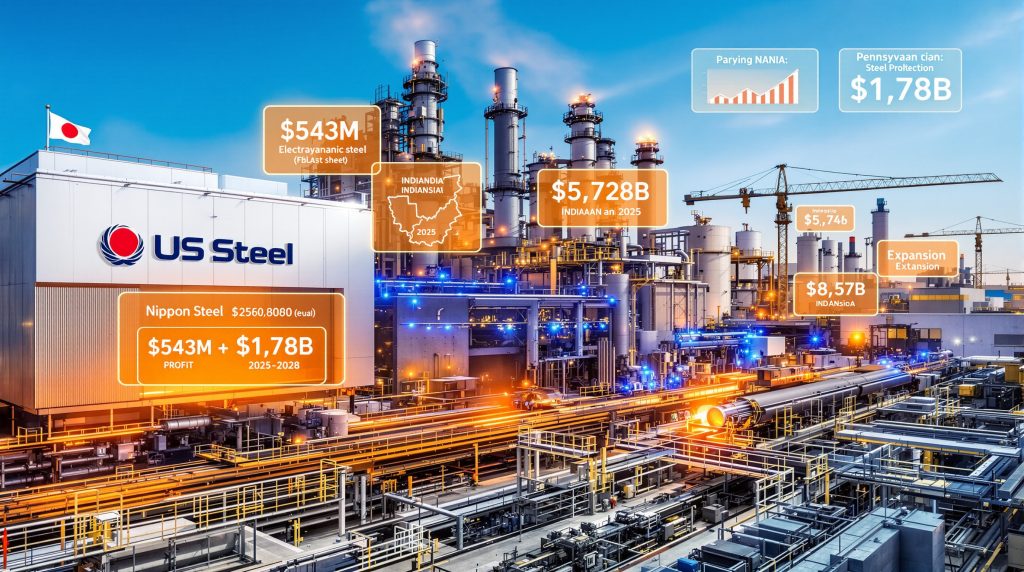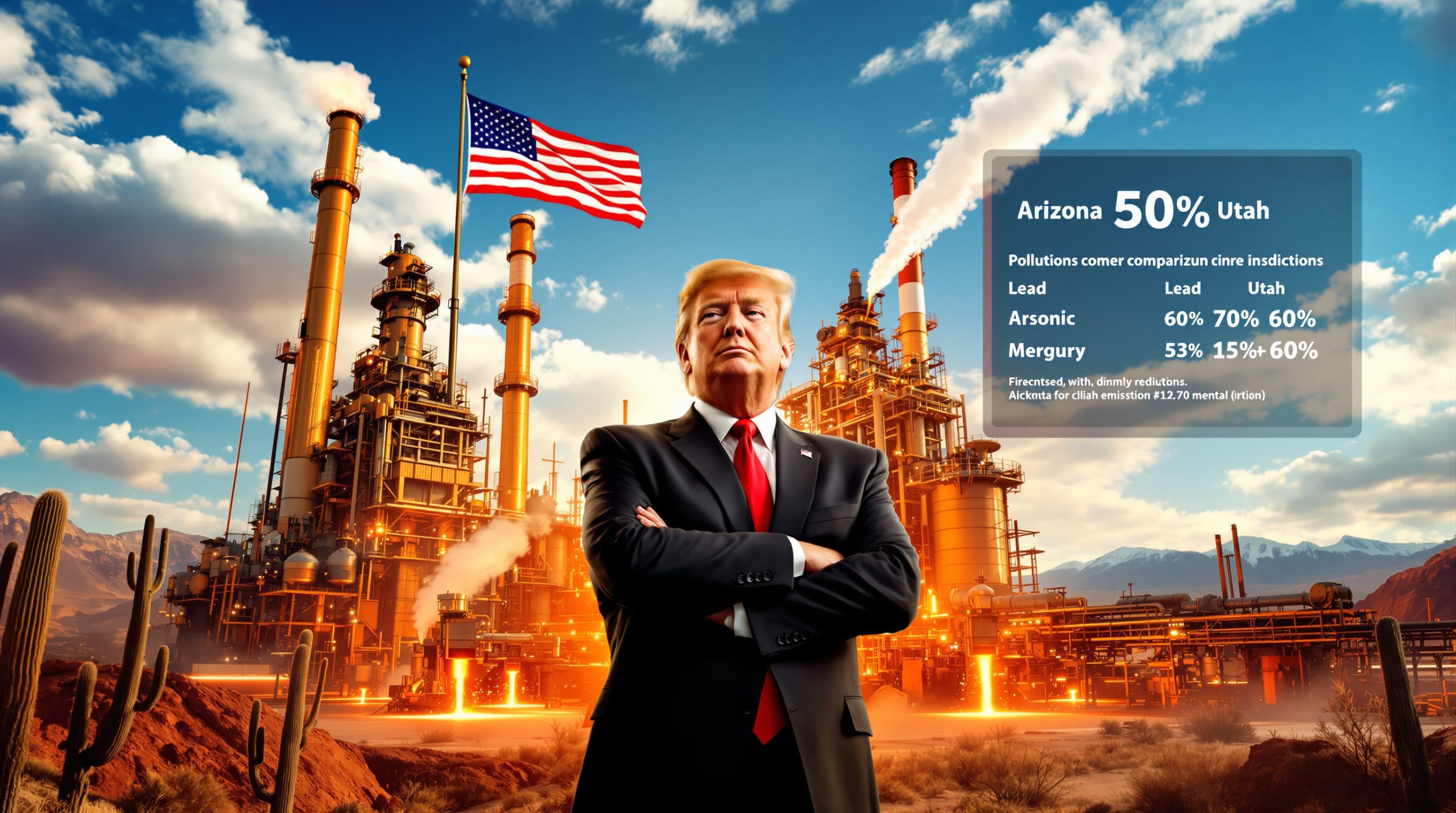What Does Nippon Steel's $11B Investment in US Steel Include?
Nippon Steel's landmark $11 billion investment in US Steel represents one of the most significant capital injections into American steel manufacturing in decades. This comprehensive investment package targets strategic infrastructure upgrades across multiple US Steel facilities, promising to modernize production capabilities and boost overall capacity throughout the company's North American operations.
Major Infrastructure Projects and Capacity Expansion
The investment blueprint includes several cornerstone projects designed to revitalize US Steel's aging infrastructure while significantly expanding production capabilities. At the Mon Valley Works in Pennsylvania, plans include construction of a new state-of-the-art hot-rolling mill, a facility crucial for transforming semi-finished steel slabs into thinner, more versatile steel sheets.
In Indiana, the investment will fund a complete refurbishment of the No. 14 blast furnace at Gary Works, one of the largest integrated steel mills in North America. This renovation will extend the operational lifespan of this critical asset while improving its efficiency and environmental performance.
Perhaps most forward-looking is the planned construction of new electromagnetic steel sheet production lines. These specialized facilities will produce the high-grade electrical steel increasingly demanded by manufacturers of electric vehicles, transformers, and renewable energy infrastructure.
Looking beyond upgrades to existing facilities, Nippon Steel Vice Chairman Takahiro Mori has confirmed intentions to "build a new mill from the greenfield," referencing the possibility of developing 3 million metric-ton electric arc furnaces similar to the Big River 2 plant in Arkansas. This represents a major commitment to electric arc furnace (EAF) technology, which offers more flexible production capabilities and typically lower environmental impacts than traditional blast furnaces.
The combined effect of these investments will be transformative for US Steel's production capacity. Currently standing at approximately 17 million tons of domestic crude steel capacity, the investment is projected to increase this figure to around 20 million tons—an 18% expansion that significantly strengthens the company's market position.
Technology Transfer and Operational Improvements
Beyond physical infrastructure, the investment includes a comprehensive transfer of Nippon Steel's advanced operational techniques and cutting-edge steelmaking technologies. This knowledge transfer represents a significant value component that extends beyond the headline $11 billion figure.
Japanese steelmaking is globally renowned for its precision manufacturing processes, quality control systems, and operational efficiency. The implementation of these techniques across US Steel's operations promises to elevate production standards while reducing waste and improving yield rates.
The technology transfer will focus particularly on high-grade product development, enabling US Steel to shift its product mix toward more specialized, higher-margin steel varieties. This strategic repositioning addresses growing market demand for advanced steel grades used in automotive manufacturing, electrical applications, and construction.
Production efficiency improvements will extend beyond individual process optimizations to encompass entire manufacturing systems. From raw material handling through finishing and distribution, Nippon Steel's methodologies aim to reduce costs while enhancing product consistency and quality.
Why Is Nippon Steel Making This Massive Investment?
The $11 billion commitment represents a strategic calculation by Nippon Steel, balancing short-term costs against long-term positioning in the global steel market. While the immediate financial impact is substantial, the company's leadership has articulated a clear vision for how this investment will generate returns over the coming years.
Financial Growth Projections
Nippon Steel has outlined specific profit contribution targets from US Steel following the investment. According to Vice Chairman Takahiro Mori, the company expects US Steel to contribute approximately 80 billion yen ($543 million) to Nippon Steel's bottom line in fiscal year 2025.
This profit contribution is projected to nearly double to 150 billion yen ($1.02 billion) by fiscal year 2026, reflecting the initial benefits of operational improvements and technology transfer. By fiscal year 2028, as major infrastructure projects reach completion, the profit contribution is expected to reach 250 billion yen ($1.70 billion).
Notably, Mori has emphasized that "real effects from the investment will appear after 2028," suggesting that the company anticipates continued profit growth beyond these initial projections. This long-term outlook aligns with the substantial nature of the infrastructure improvements being undertaken.
The financial projections incorporate currency exchange considerations, with all yen figures calculated at approximately $1 = 147.33 yen based on exchange rates at the time of announcement. This exchange rate exposure represents both a risk and opportunity for the investment's dollar-denominated returns.
Global Market Position Enhancement
Beyond immediate financial returns, the acquisition and subsequent investment significantly advance Nippon Steel's global strategic positioning. The deal increases Nippon Steel's global annual crude steel capacity to 86 million tons, representing major progress toward the company's longer-term 100-million-ton production target.
This capacity expansion strengthens Nippon Steel's competitive standing against other global steel giants, particularly those in China, South Korea, and Europe. In an industry where economies of scale provide significant advantages in both procurement and operational efficiency, this increased scale improves Nippon Steel's relative market position.
The investment also achieves important geographic diversification, reducing Nippon Steel's historical concentration in Asian markets. By establishing a major production base in North America, the company gains protection against regional economic downturns while positioning itself to capitalize on investment strategy insights in the United States.
How Will This Deal Transform Both Companies?
The partnership between Nippon Steel and US Steel promises to be transformative for both organizations, creating new opportunities while addressing historical challenges. The $11 billion investment serves as the foundation for this transformation, enabling strategic initiatives that neither company could easily pursue independently.
Strategic Benefits for Nippon Steel
For Nippon Steel, the acquisition and subsequent investment dramatically expand its North American manufacturing footprint. Prior to the acquisition, Nippon Steel's presence in the US market was relatively limited compared to its global scale. The deal provides immediate access to US Steel's extensive production network, including its integrated blast furnace operations and electric arc furnace facilities.
This expanded presence provides Nippon Steel with direct access to US Steel's established customer base and distribution networks. Rather than building these relationships from scratch—a process that would typically take decades—the acquisition allows Nippon Steel to immediately engage with major North American steel consumers in automotive, construction, energy, and manufacturing sectors.
The deal also significantly diversifies Nippon Steel's revenue streams across global markets. This geographic diversification helps insulate the company from regional economic fluctuations, creating a more stable financial foundation. When demand weakens in Asian markets, stronger North American performance may help offset the impact.
The increased scale also enhances Nippon Steel's economies in procurement, allowing for more favorable terms when purchasing raw materials like iron ore and coking coal. These scale benefits extend to operational aspects as well, enabling more efficient allocation of capital, research resources, and specialized expertise across a broader production base.
Transformation Potential for US Steel
For US Steel, the partnership brings access to Nippon Steel's world-class technological capabilities and manufacturing expertise. This knowledge transfer addresses a historical challenge for US Steel, which has struggled to maintain technological competitiveness with newer, more efficient producers both domestically and internationally.
The investment enables comprehensive modernization of aging infrastructure and production facilities. Many of US Steel's core assets were constructed decades ago and require significant capital investment to remain competitive. The $11 billion commitment provides the financial resources necessary for this modernization without requiring unsustainable leverage.
Implementation of Japanese manufacturing techniques promises to improve operational efficiency throughout US Steel's production network. These improvements include enhanced process control, reduced energy consumption, lower maintenance costs, and improved yield rates—all contributing to stronger financial performance.
Perhaps most significantly, the partnership enables US Steel to enhance its product portfolio with higher-margin steel products. By leveraging Nippon Steel's expertise in specialized steel grades, US Steel can shift its production mix away from commodity products toward more technically demanding applications that command premium pricing.
These improvements collectively strengthen US Steel's competitive position in North American markets, allowing it to better withstand competition from both domestic mini-mills and international producers. The partnership creates a more sustainable business model built on technological advantage rather than protective trade measures.
What Challenges Does the Investment Face?
Despite its strategic rationale, the $11 billion investment program faces several significant challenges that will require careful management. These challenges span financial, operational, and cultural dimensions, each requiring dedicated attention from leadership teams at both companies.
Financial Considerations
The financing structure for both the acquisition and subsequent investment involves complex arrangements designed to balance multiple objectives. Nippon Steel has indicated it will raise 500 billion yen through a subordinated loan to partially repay a 2 trillion yen bridging loan that funded the initial $14.9 billion acquisition which closed in June.
Looking forward, Nippon Steel is evaluating multiple financing options for the investment program, including hybrid financing instruments, convertible bonds, and corporate bonds. Vice Chairman Mori has indicated the company will "assess the optimal timing, interest rates, and whether yen or dollar denominations are preferable to pursue the best financing strategy."
While equity financing remains an option, Mori has emphasized it would only be considered "within limits to avoid shareholder dilution." This constraint reflects the company's commitment to protecting existing shareholder interests while pursuing growth opportunities.
The initial funding responsibility for the $11 billion investment will fall to US Steel, with Nippon Steel prepared to provide support if resources prove insufficient. This arrangement leverages US Steel's existing financial capabilities while establishing a clear backstop for the investment program.
Operational Hurdles
Beyond financing challenges, the investment program faces significant operational hurdles as it moves from planning to implementation. One immediate challenge involves integrating different corporate cultures and operational philosophies between the Japanese parent company and its American subsidiary.
While implementing facility upgrades and expansions, both companies must carefully manage potential production disruptions to minimize impact on customers. This balancing act requires detailed planning and coordination across multiple facilities and production lines.
Recent operational challenges highlight the unpredictable nature of steel manufacturing. An August explosion at US Steel's Clairton plant in Pennsylvania could potentially reduce the expected 80 billion yen profit contribution for the current fiscal year. While Mori has indicated this impact would "not be significant," it illustrates the operational risks inherent in steel production.
Throughout the investment program, leadership must balance modernization initiatives with maintaining current production levels to fulfill customer commitments. This dual mandate creates tension between long-term improvement and short-term performance that requires careful management.
How Does This Investment Impact the Global Steel Industry?
The Nippon Steel-US Steel partnership and subsequent investment program have significant implications for the broader steel industry. As one of the largest steel industry transactions in recent years, the deal influences industry dynamics from market structure to production technology.
Market Consolidation Implications
The acquisition accelerates the ongoing global trend toward steel industry consolidation trends. As major producers combine operations to achieve greater scale and efficiency, the industry's competitive landscape continues to evolve. This consolidation trend responds to persistent challenges including overcapacity, cyclical demand, and intense price competition.
The partnership will likely trigger competitive responses from other major steel producers seeking to maintain or improve their relative market positions. These responses could include similar cross-border acquisitions, strategic investments, or focused capacity expansions in high-growth product categories.
Market consolidation typically influences pricing dynamics as larger producers gain increased market leverage. While competition remains intense across most steel product categories, the reduced number of major producers may provide opportunities for more stable pricing in specialized market segments.
The partnership also potentially shifts global steel trade patterns as production decisions increasingly reflect the integrated operations of multinational producers rather than independent national companies. These shifts may alter traditional import-export relationships between major steel-producing and steel-consuming regions.
Production Technology Evolution
Beyond market structure, the investment accelerates the industry evolution trends across the industry. Nippon Steel's commitment to both blast furnace refurbishment and new electric arc furnace capacity reflects the industry's hybrid technological future, combining traditional and emerging production methods.
The emphasis on high-efficiency production methods establishes new benchmarks for operational performance throughout the industry. As competitors respond to these efficiency improvements, overall industry productivity will likely increase, potentially addressing longstanding concerns about steel industry competitiveness.
The investment's focus on specialized steel products, particularly electromagnetic steel sheet for electrical applications, highlights the growing importance of these high-value categories. Industry investment patterns will likely continue shifting toward these specialized products that support emerging technologies in renewable energy, electric vehicles, and advanced manufacturing.
The transfer of Japanese manufacturing techniques into US operations represents a significant diffusion of production knowledge across international borders. This knowledge transfer may accelerate the adoption of similar techniques by other North American producers seeking to remain competitive.
What Are the Economic and Political Implications?
The $11 billion investment program carries significant economic and political implications that extend beyond the steel industry itself. As a major commitment to US manufacturing infrastructure, the investment influences multiple aspects of the economic and political landscape.
Impact on US Manufacturing Sector
The investment promises to revitalize traditional US steel manufacturing infrastructure at a time when much industrial investment has focused on either service industries or emerging technology sectors. This commitment to core manufacturing capability helps maintain the industrial foundation that supports broader economic activity.
While specific job creation projections have not been released, the capacity expansion from 17 million to 20 million tons suggests meaningful employment growth across multiple facilities. These positions typically provide above-average wages and benefits, supporting middle-class employment in regions that have experienced manufacturing job losses.
The modernization of US Steel's facilities enhances the competitiveness of US-based steel production against both domestic mini-mills and international competitors. This improved competitiveness reduces reliance on trade protection measures while strengthening domestic manufacturing capabilities.
Enhanced local production of specialized steel grades strengthens supply chains for domestic manufacturing, providing more reliable access to critical materials for industries ranging from automotive to defense. This supply chain resilience has gained increased importance following recent global disruptions.
Political Considerations
The acquisition's completion in June 2025 followed a complex regulatory review process that bridged the transition between political administrations. This successful navigation of regulatory hurdles demonstrates the deal's perceived alignment with broader economic interests despite initial political concerns.
Foreign investment in strategic US industries continues to receive heightened scrutiny from policymakers across the political spectrum. The investment program's focus on expanding domestic production capacity and creating US manufacturing jobs helps address potential concerns about foreign control of critical industries.
The partnership potentially influences US-Japan trade relations by creating a significant Japanese manufacturing presence within the United States. This direct investment creates shared economic interests that may influence trade policy discussions between the two countries.
Policymakers face ongoing challenges in balancing the benefits of foreign investment with concerns about domestic industry protection. The Nippon Steel-US Steel partnership provides a test case for how these competing priorities can be reconciled through investment commitments and operational guarantees.
What Does This Mean for Steel Markets and Customers?
For steel markets and customers, the $11 billion investment program promises significant changes in product availability, quality, and supply chain dynamics. These changes will unfold gradually as infrastructure improvements and operational enhancements are implemented across US Steel's operations.
Product Portfolio Expansion
The investment emphasizes expanding the availability of high-grade steel products in the North American market. This expansion includes specialized steel grades for automotive applications, construction, energy infrastructure, and manufacturing. Customers in these sectors will benefit from improved local access to advanced steel varieties previously available primarily through imports.
Enhanced electromagnetic steel sheet production represents a particularly significant development for manufacturers of electrical equipment. This specialized steel, critical for transformers, electric motors, and power distribution equipment, plays an essential role in grid modernization and electrification initiatives.
Beyond these specific products, the investment enables US Steel to develop new specialty steel offerings that address emerging customer requirements. The technology transfer from Nippon Steel provides the metallurgical expertise necessary to formulate and manufacture these advanced steel grades.
Improved quality consistency resulting from technological upgrades benefits customers through reduced variability in material properties. This consistency enables more precise engineering specifications, potentially reducing material waste and improving end-product performance.
Supply Chain Implications
The investment strengthens integrated supply capabilities for North American manufacturers, providing more reliable access to both commodity and specialized steel grades. This enhanced reliability is particularly valuable following recent supply chain disruptions that highlighted vulnerabilities in global material sourcing.
Local production of specialized steel grades enables more responsive manufacturing, with shorter lead times and greater flexibility to address changing customer requirements. This responsiveness provides a competitive advantage compared to imported alternatives that typically involve longer supply chains.
The partnership enhances supply stability for critical US industries, reducing exposure to international trade disruptions, shipping delays, and foreign supply constraints. This stability is particularly valuable for industries with just-in-time manufacturing systems that depend on predictable material availability.
While specific pricing implications remain uncertain, the investment's focus on operational efficiency may help moderate steel price volatility. Improved production flexibility allows more responsive adjustment to demand fluctuations, potentially reducing the extreme price swings that have characterized steel markets in recent years following the iron ore price decline analysis and tariffs impact on metal markets.
What's Next for the Nippon Steel-US Steel Partnership?
As the partnership moves from acquisition to implementation, several key developments will shape its evolution and impact. The coming months and years will bring increased clarity about specific projects, timelines, and strategic priorities.
Upcoming Strategic Announcements
A detailed investment plan is scheduled for release later in 2025 as part of Nippon Steel's new medium-term business strategy. This announcement will provide greater specificity about project priorities, implementation timelines, and expected performance improvements.
Takahiro Mori, who served as lead negotiator on the deal and now chairs US Steel, will likely play a central role in articulating the partnership's strategic vision. His dual perspective provides valuable insight into how the investment program aligns with Nippon Steel's global objectives.
The companies may identify additional acquisition or expansion targets that complement the current investment program. These supplementary initiatives could address specific product categories, geographic markets, or technological capabilities not fully covered by the initial $11 billion commitment.
Further announcements regarding technology transfer and implementation phases will clarify how quickly operational improvements will be realized. These timelines will influence customer expectations and competitive responses throughout the industry.
Long-Term Vision
Beyond the initial investment period, the partnership envisions continued capacity expansion that builds on the foundation established through current projects. This expansion may include additional electric arc furnace capacity, specialized finishing lines, or enhanced logistics infrastructure.
Further integration of operations and management systems will likely occur as the partnership matures. While maintaining separate corporate identities, the companies will increasingly function as an integrated production network with coordinated strategy and resource allocation.
The partnership positions both companies to potentially develop next-generation steel production technologies that address emerging challenges in decarbonization, energy efficiency, and material performance. These innovation initiatives may attract additional investment beyond the initial $11 billion commitment.
Looking forward, the combined entity will continue evolving its product portfolio to address changing market demands across construction, automotive, energy, and manufacturing sectors. This evolution will reflect both technological developments and shifting customer requirements in each sector.
FAQ: Nippon Steel's Investment in US Steel
How will the $11 billion investment be allocated across different facilities?
The investment will be distributed across multiple US Steel facilities, with major projects including a new hot-rolling mill at Mon Valley Works in Pennsylvania, refurbishment of the No. 14 blast furnace at Gary Works in Indiana, new electromagnetic steel sheet production lines, and potentially a new greenfield mill with electric arc furnaces similar to the Big River 2 plant in Arkansas. The detailed allocation across facilities will be clarified when the companies release their comprehensive investment plan later in 2025.
When will the financial benefits of this investment begin to materialize?
According to Nippon Steel Vice Chairman Takahiro Mori, incremental profit contributions are expected to grow from 80 billion yen ($543 million) in fiscal year 2025 to 250 billion yen ($1.70 billion) by fiscal 2028. However, Mori has emphasized that "real effects from the investment will appear after 2028," suggesting the most significant financial benefits will materialize beyond the initial implementation period. This timeline reflects the long-term nature of major infrastructure investments in steel manufacturing.
How will Nippon Steel finance this massive investment?
The financing strategy includes a 500 billion yen subordinated loan to partially repay a 2 trillion yen bridging loan that funded the acquisition. Additional options under consideration include hybrid financing instruments, convertible bonds, and corporate bonds. While equity financing remains possible, Mori has indicated it would only be considered "within limits to avoid shareholder dilution." Initially, US Steel will fund the investments with Nippon Steel providing support if needed.
What impact will this investment have on US Steel's production capacity?
The investment is expected to increase US Steel's domestic crude steel capacity from approximately 17 million tons to 20 million tons, representing an 18% expansion in production capability. This capacity increase will be achieved through a combination of efficiency improvements at existing facilities and construction of new production assets, including potential electric arc furnace capacity at a greenfield location.
Ready to Track the Next Major Mineral Discovery?
Discovery Alert's proprietary Discovery IQ model provides real-time notifications when significant ASX mineral discoveries are announced, giving investors a crucial edge before market movements occur. Visit the Discovery Alert discoveries page to see how historic discoveries have delivered exceptional returns, and start your 30-day free trial today.




